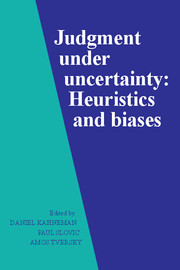Book contents
- Frontmatter
- Contents
- List of contributors
- Preface
- Part I Introduction
- Part II Representativeness
- Part III Causality and attribution
- Part IV Availability
- Part V Covariation and control
- Part VI Overconfidence
- Part VII Multistage evaluation
- Part VIII Corrective procedures
- 28 The robust beauty of improper linear models in decision making
- 29 The vitality of mythical numbers
- 30 Intuitive prediction: Biases and corrective procedures
- 31 Debiasing
- 32 Improving inductive inference
- Part IX Risk perception
- Part X Postscript
- References
- Index
31 - Debiasing
Published online by Cambridge University Press: 05 May 2013
- Frontmatter
- Contents
- List of contributors
- Preface
- Part I Introduction
- Part II Representativeness
- Part III Causality and attribution
- Part IV Availability
- Part V Covariation and control
- Part VI Overconfidence
- Part VII Multistage evaluation
- Part VIII Corrective procedures
- 28 The robust beauty of improper linear models in decision making
- 29 The vitality of mythical numbers
- 30 Intuitive prediction: Biases and corrective procedures
- 31 Debiasing
- 32 Improving inductive inference
- Part IX Risk perception
- Part X Postscript
- References
- Index
Summary
Once a behavioral phenomenon has been identified in some experimental context, it is appropriate to start questioning its robustness. A popular and often productive questioning strategy might be called destructive testing, after a kindred technique in engineering. A proposed design is subjected to conditions intended to push it to and beyond its limits of viability. Such controlled destruction can clarify where it is to be trusted and why it works when it does. Applied to a behavioral phenomenon, this philosophy would promote research attempting to circumscribe the conditions for its observation and the psychological processes that must be evoked or controlled in order to eliminate it. Where the phenomenon is a judgmental bias, destructive testing takes the form of debiasing efforts. Destructive testing shows where a design fails; when a bias fails, the result is improved judgment.
The study of heuristics and biases might itself be seen as the application of destructive testing to the earlier hypothesis that people are competent intuitive statisticians. Casual observation suggests that people's judgment is generally “good enough” to let them make it through life without getting into too much trouble. Early studies (Peterson & Beach, 1967) supported this belief, indicating that, to a first approximation, people might be described as veridical observers and normative judges. Subsequent studies, represented in this volume, tested the accuracy of this approximation by looking at the limits of people's apparent successes. Could better judgment have made them richer or healthier?
- Type
- Chapter
- Information
- Judgment under UncertaintyHeuristics and Biases, pp. 422 - 444Publisher: Cambridge University PressPrint publication year: 1982
- 378
- Cited by

